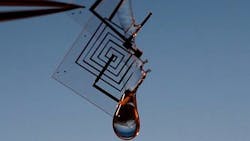MORSECORP joins DARPA program for air-drop unmanned aircraft that melt for stealth and secrecy
Officials of the U.S. Defense Advanced Research Projects Agency (DARPA) in Arlington, Va., added MORSECORP Inc. in Cambridge, Mass., to the Inbound, Controlled, Air-Releasable, Unrecoverable Systems (ICARUS) program.
MORSECORP joins the Xerox Palo Alto Research Center (PARC) in Palo Alto, Calif., and DZYNE Technologies Inc. in Fairfax, Va., on the ICARUS program, which seeks to design and demonstrate a precision autonomous guided air-delivery vehicle that vanishes on command.
MORSECORP specializes in vehicle guidance, navigation, and control; mission planning; multi-vehicle autonomy; computer vision; and mobile computing.
Related: Air Force ready to approach industry for enabling technologies in affordable attack drones
The ICARUS approach is similar to the DARPA Vanishing Programmable Resources (VAPR) program to develop sensitive electronic components able to self-destruct on command to keep them out of the hands of potential adversaries.
MORSECORP won a $1.8 million ICARUS phase-one contract last Friday, and a $1.3 million option for phase two. PARC, meanwhile, won a $2.3 million contract on 3 June for ICARUS phase one, while DZYNE won a $2.9 million phase-one ICARUS contract on 10 June. The PARC contract has a $1.6 million option for phase 2, while the DZYNE contract has a $3.2 million option for phase 2.
PARC also is involved in the VAPR program, as are IBM Corp. in Armonk, N.Y.; SRI International in Menlo Park, Calif.; and Honeywell Aerospace Microelectronics & Precision Sensors segment in Plymouth, Minn.
ICARUS is asking MORSECORP, PARC, and DZYNE to develop a vanishing unmanned aerial vehicle (UAV) able to deliver a small package no larger than 3 pounds to a GPS-programmed location with 33-foot accuracy.
Related: The coming age of the military micro-drone
The small aircraft, which the companies will develop to operate at night, must be able to vanish within four hours of landing, leaving remnants no larger than 100 microns -- or about the width of a human hair.
DARPA officials say they expect to make several contract awards for the ICARUS program, so additional contractors may be named.
Today the supply and re-supply of small military and civilian teams in rough terrain, such as sniper teams and Special Forces , requires large parachute-delivery systems that must be packed-out after payload delivery for security and environmental concerns.
Vanishing precision-delivery vehicles would enable efficient resupply to teams in distributed locations, eliminate the need to pack-out delivery parachutes, and deliver time-critical humanitarian supplies to personnel serving in remote or dangerous areas, DARPA officials say.
Related: BAE Systems to develop MAD ASW drone to help Navy P-8A find submarines from high altitudes
The vanishing vehicles that MORSECORP, PARC, and DZYNE will develop must be no larger than 10 feet in their largest dimension, and be able to glide for nearly 100 miles when released from altitudes of 35,000 feet.
DARPA researchers primarily want to determine if a large structure can be made transient cheaply enough to be disposable such that they limit the logistics trail, and make the most of range. Critical technical challenges facing the ICARUS program cover two major categories: aerodynamics and materials.
The ICARUS program will span two phases and 26 months culminating in a field-test of vanishing precision air delivery prototypes.
MORSECORP, PARC, and DZYNE are involved in the first phase, which will develop and demonstrate an air delivery vehicle using nontransient materials, but using a manufacturing process using the transient materials. The optional second phase will fabricate a field testable, vanishing air delivery vehicle.
For more information contact MORSECORP online at www.morse-corp.comPARC at www.parc.com, DZYNE Technologies at www.dzynetech.com, or DARPA at www.darpa.mil.
